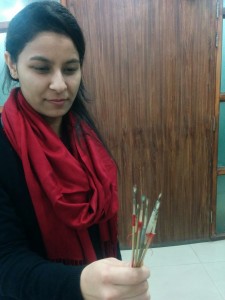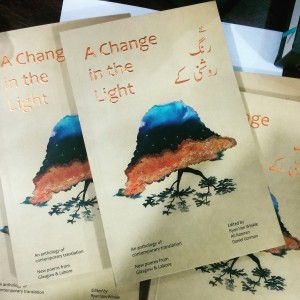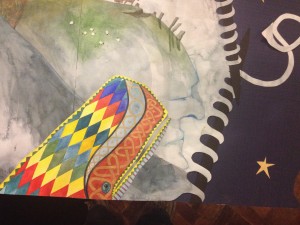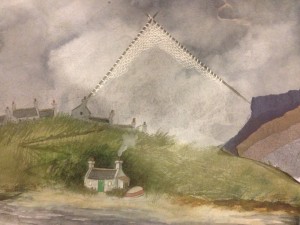Tales of Two Storytellers Pt. 2
26th February 2016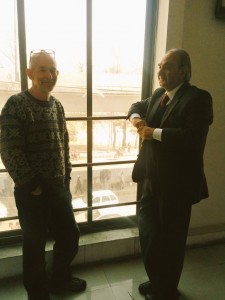 Ian Stephen is a novelist, poet & storyteller. We brought him to Lahore to work with a Pakistani storyteller to share tales and create new ones. You can read Ian’s first impressions here…
Ian Stephen is a novelist, poet & storyteller. We brought him to Lahore to work with a Pakistani storyteller to share tales and create new ones. You can read Ian’s first impressions here…
We did our bit, towards the close of play at Lahore Literary Festival. The banner of land and seascapes by Mehreen Fatima and Kate Leiper was unrolled for projection for a large and lively audience. The artists moved it under a video camera and zoomed into details as they occurred in the collage of tales stitched together in a week by Mujahid Eshal and this cove.
But first Gerry Cambridge breathed wonders into his moothy and the wailing melodies moved between blues and Gaelic and oriental-seeming phrases.
From not long after arriving at Lahore airport the Monday before, till close of play on the Friday, I’d sat with Mujahid (my new uncle) and talked over both literary short stories and the tales which have been passed on without a written script. If the Iliad and the Odyssey were told intact, we should be able to manage an exchange of two or three yarns, without paper or computer. First I learned of the work of Manto, a prolific Lahore-based writer of short stories and a Bohemian legend in the city.
https://www.youtube.com/watch?v=0sWHrXyobE0
Mujahid’s portrait, in spoken words, reminded me of the story of Guy de Maupassant. My learned collaborator has translated a first volume of Manto’s non-fiction works from Urdu to English and a second is ready for publication by our hosts, the Sang-E -Meel bookshop and publishers. Mujahid then set out to write and recite a first short story of his own.
This phase of our work was to translate into an introduction into our performance, in Urdu and English, by Mujahid, comparing the written with the spoken story. Then we were into tales which the illustrators could respond to. Kate suggested that the reason all these improbable mythologies still fascinate us is that they are psychologically accurate. Our fears are contained within the narratives and their resolutions offer hope or solace. For me, the discussion related closely to a tentative essay, the shadow of a backbone in my own first work of non-fiction, which is ‘under offer’ from more than one publisher right now.
I knew Kate’s work from the superb detailed imagery in beautifully-produced children’s books from Floris Books, Edinburgh. Mehreen trained as a miniaturist and uses home-made brushes with a wisp of squirrel’s tail hair. There is a strong aesthetic correspondence in their work. The joins are seamless.
At first we went for a similar close correspondence in the stories. The tale of three brothers, with the youngest as a troublesome but clever trickster, had a central image of a captive in a sack. I thought at once of the Luckie Minnie ogre tale from Fair Isle. Mujahid’s account of a diver in a cage who outwits a crocodile-like creature brought the Irish story of King Fergus to my mind. He also went below the surface of water, assisted by a magical pair of boots. At first this new kingdom is mesmerising but he also meets a beast with savage jaws and escapes the physical danger but with a face that will show fear until he at last dares to re-enter the sub-marine territory. Kate’s suggested psychological approach seems to work for all of these.
Many folk tales of the Punjab take the form of ballad-like tragedies of lovers who meet in death, such as the story of Heer, preserved in at least two different long poems. Several similar legends are based on verses which were passed on by recitation before they were written. Mujahid conjured up the image of the porous clay urn which failed to support one such unhappy man, attempting to cross a stream to meet his beloved. That evokes the Gaelic song, Ailein Duinn where a sailor drowns on the voyage to his wedding but his body washes up with that of his bride. The discussion on why unlikely stories still work for us now, could go on for ever. Maybe that is why we decided to perform the stories rather than discuss them and trust to a less explicit linking of our chosen tales.
In contrast, most of the book-festival events were chaired discussions. The exception was the poetry performance by the Glasgow and Lahore based folk who have now had several meetings to discuss and translate each other’s work. Sang-E-Meel were launching their collection of inter-city poems and translations, presented with a striking cover-design, which includes one of Mehreen’s paintings. The book is edited by Ryan Van Winkle (winner of the 2015 Saltire prize for a poetry collection), Ali Kamran, (third generation partner in the Lahore publishing company) and Daniel Gorman of Highlight Arts, who set up this partnership with Edinburgh Book Festival as part of an ongoing project which furthers cultural exchanges in areas of conflict.
The poets put on a show, compered by Ryan and interspersed with examples of a powerful musical collaboration. Sarah Hayes bent the notes on a silver flute to bring the drone of the pipes to the show and Sara Kazmi made an instrument of her voice, which reminded me of Gaelic mouth-music. The translations sounded like poems in their own right – and this was confirmed when I entered the book ‘A Change in the Light’. The range of work is wide, from Khalid Javaid Jan’s Ginsberg-like expression of the right to free speech to Gerry Cambridge’s intimate memoire of his father, carried by a word-drawing of his train-set.
Both were well-served by their translators, Jim Carruth preserved the rhythms and outrage which were obvious in the Urdu work and the reactions to Khalid’s version of Gerry’s poem showed that the images and sentiment crossed water and mountains. But all the poets demonstrated a genuine engagement with each other’s work and all the poems were strong, on and off the page.
This was one of the shows re-scheduled after a last minute shuffle of both timing and venue. The organisers have to be congratulated for responding to the huge challenge of these last minute conditions for a license for continuing. The reasoning behind such conditions did not pass without comment in public and private forums. I did not expect the level of political engagement nor the sheer scale of a festival attended by many thousands.
Our small troupe of storytellers and illustrators performed towards the close of the whole show. A generous audience coped with the technical issues inevitable when such changes have to be made. I would say that the performance was an honest sharing of a work-in-progress. Thanks to the partnership with the Edinburgh International Book Festival, we will have a chance to do it again with a bit of time to consolidate what we gained in the process of our week of working together. But I’ve come home safe with at last one story, new to me, which I’m sure will have resonance here. And I hope I may have left a couple in my own traveller’s wake.
Now that I’m back in a snowy February, I’ll share the story by telling it on the page. Of course there is the proviso that this is only one telling at a given time. It happens to be in writing. If I wrote it again in a week it would probably differ in its grace-notes though not in the shape of the narrative. When I tell it, I won’t refer to any text but trust that our friendly conferences, fed by chai and chapatis, have left me with something to share.
This is the story
(the clever wife who outwits her ‘superiors’ surfaces in different continents but this example, linked to the Punjab is indebted to this folktake.)
Once there was a king who lived within elegant buildings in an ordered garden. Trees and fruit-bushes were fed by the fall of water through canals. The calming fall of water from fountains would continue the music, even when the court-musicians were resting. But now and again stories from the dusty, sweaty and disordered world outwith the walls would come to the ears of the king. He heard word of a woodsman, or rather the wife of that man. These were poor people but they said the wife was more clever than anyone else in the land. None of the many advisors to the king could match her for wit and wisdom, they said.
At last, the king resolved to investigate these claims. He sent a fakir to the simple dwelling where the woodsman lived with his wife and their three sons. This man had powers gained from many years of thinking and walking far into the wilderness. He stationed himself at the edge of the wood. He knew that all who worked here must pass this way. First the woodsman sent his eldest son to prepare the way for the tasks of the day. He passed the fakir who greeted him.
‘Before you lift a tool today, I have something to offer you. How would you like to know what will happen to you tomorrow and further into the future?’ Of course the eldest son could not resist. ‘But first you must tell me what you make of this sight.’
And at once the morning haze took a shape. You could see the nodding blades of golden corn in a field ready for harvest. It was surrounded by a high picket-fence of sticks, bound together. As they watched the slats of wood changed to reaping tools. They came alive and slashed the corn till not a stalk still stood.
‘And what does this suggest to you?’
‘Who knows?’ was the reply.
‘Well your future is easy to tell.’ A thin hand moved and the lad was transformed into a still shape of stone.
Next came the second son. The same offer was put to him and again he agreed. But this time the
vision was different. A fine cow came into sight followed by her calf. The glossy coat of the cow spoke
for itself but the calf was a poor scrawny thing. As they watched, the cow bent her head and began to feed of the calf.
‘And what does that suggest to you.’
‘No idea,’ said the second son.
‘Your future is a simple matter.’ He too became stone.
The third son appeared a moment later and he too accepted the offer. The vision revealed an old man, bent over and struggling under the weight of his huge burden of branches. He was stooped almost to the ground but still he bent to clutch one more stick, whether his back could take it or not.
‘And the meaning of this?’
‘It has no meaning. It is only a picture.’
He too became stone. Their father was the next to come over the rise of ground at the edge of the wood. He was by now quite an old man but he still wanted to see what was in store for him. The haze shone till a new landscape appeared. A great lake shimmered out and wide as far as you could see. Streams ran from it and these filled pool after pool, all around. But no water flowed back into the lake. As they watched, that source which seemed limitless emptied to a muddy wasteland.
‘What do you make of that?’
‘Nothing at all.’
‘Your future will also be nothing.’ And he became the fourth tall stone.
When her sons and her husband failed to return for food, the woodsman’s wife left their hut to search for them. She stumbled across the waiting fakir. ‘Have you seen three lads and their father?’
‘If you are as clever as they say, you will be able to tell me where they are now.’
She looked around, puzzled at first, till her eye fell on the stones. ‘Why have you changed their shape?
I’m sure they did nothing to harm you.’
‘Maybe so but they could not interpret the visions set before them. If you can succeed where they failed, they will be restored to you. If not, there will be five stones.’
The woman took the challenge and so the fakir revealed the same scenes he had produced for the men of the house.
When the field of corn faded he looked to the woodsman’s wife for a response. She smiled.
‘The corn is the wealth of the kingdom and the sticks are those who are given custody of it. Instead of guarding it they take it, little by little, till nothing is left to protect.’
Next she was shown the healthy cow and the frail calf. ‘I have seen this all too often,’ said the woman.
‘We should nourish our children when they are young, make sacrifices for them and allow them to grow and become their own selves. Instead, we burden them with our own wants. We try to live through them and so we take their strength away from them.’
When she was shown the old man with his burden she nodded and said, ‘Even when we find as much as we need, some must gather on and make a heavier burden for themselves.’
Finally, the draining lake was shown to her. This time the woodsman’s wife looked sad.
‘That is the way of the world. We need water for life and there is enough for all. But something must flow back into that lake or else it will be drained, in time.’
This time the fakir passed his hand over the four stones and the husband and three sons were returned to life. ‘Your future is secure and so is that of your family if you are willing to share.’
Of course the king sent the clever wife a bag of gold when he heard the report of the fakir. She used it with care and it was enough to see that the whole family and their children to come were provided for.
Notes
- Sohni Mahiwal (Urdu/Punjabi: سوہنی مہیوال Sindhi: सोहनी महीवाल) is also popular in Sindh and across South Asia. It is one of the most prominent examples of medieval poetic legends in the Punjabi and Sindhi languages. Sohni is the daughter of a potter named Tula, who lives in Gujrat on the caravan trade route between Bukhara and Delhi.[11]She draws floral designs on her father’s ‘surahis’ (water pitchers) and mugs and transform them into masterpieces of art. Izzat Baig, a wealthy trader from Bukhara (Uzbekistan), is completely enchanted when he sees the beautiful Sohni and sends his companions away without him. He takes a job as a servant in the house of Tula, and Sohni falls in love with him. When they hear rumors about the love of Sohni and Mahiwal, Sohni’s parents arrange her marriage with another potter without her knowledge. His “barat” (marriage party) arrives at her house unannounced and her parents bundle her off in the doli (palanquin). Izzat Baig renounces the world and lives like a “faqir” (hermit) in a small hut across the river. Each night Sohni comes to the riverside and Izzat Baig swims across the river to meet her. When he is injured and cannot swim, Sohni begins swimming across the river each night, using a large earthenware pitcher as a float. Her husband’s sister follows her and discovers the hiding place where Sohni keeps her earthen pitcher among the bushes. The next day, the sister-in-law replaces the pitcher with an unbaked one which dissolves in the water. Sohni drowns in the river; when Mahiwal sees this from the other side of the river, he jumps into the river and drowns with her. According to the legend, the bodies of Sohni and Mahiwal were recovered from river Indus near Shahdapur and are buried there.
- You can find more on Pakistani Folklore here.


